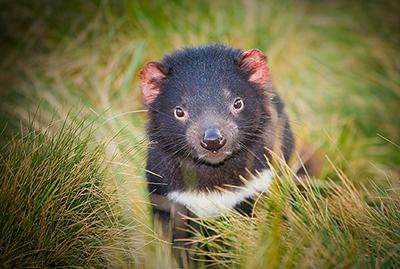Tasmanian devils under new threat from cancer, Southampton research finds

A new study has shown that the Tasmanian devil is under severe threat from a newly emerged contagious cancer, Devil Facial Tumour 2 (DFT2), which could jeopardise its future in the wild.
For more than two decades the Tasmanian devil population has been suffering from Devil Facial Tumour Disease (DFTD), which causes close to 100% mortality in the world’s largest remaining marsupial carnivore. The Tasmanian devil is listed as ‘endangered’ on the IUCN Red List of Endangered Species, with its global population reduced by more than 60% in the past 10 years due to DFTD.
The facial cancer, which spreads when the Tasmanian devils bite each other’s faces during fighting, kills its victims in a matter of months. What started with just one Tasmanian devil has now killed many thousands.
In 2014 scientists discovered that a second contagious cancer, called DFT2, had emerged and was circulating in a small number of animals. However, new research led by University of Southampton biological scientist Dr Hannah Siddle, published in eLife, has shown that this cancer has the potential to cause as much if not more damage to the already weakened population of Tasmanian devils.
Dr Siddle said: “There is a real threat that this contagious cancer could now spread very rapidly through the population. The Tasmanian devil has already been decimated by one contagious cancer and these latest findings could jeopardise its future in the wild.
On the surface of every mammalian cell is a molecule called major histocompatibility complex (MHC). These molecules enable the immune system to determine if a cell is friend or foe, triggering an immune response if the cell is foreign and a potential threat.
Dr Siddle’s study, titled ‘The newly-arisen Devil Facial Tumour Disease 2 (DFT2) reveals a mechanism for the emergence of a contagious cancer’, has found that DFT2 cells have MHC molecules, which should make them a target for the immune system.
The researchers have also found evidence that the cancerous cells may be losing their MHC, removing the targets for the immune system and making it much more likely that the cancer will be able to spread rapidly, causing more population crashes in an already vulnerable species.
Dr Siddle added: “Although this could be very bad news for the Tasmanian devil, we are in a better position than we were when the first contagious cancer emerged. We are further ahead with research and with developing captive management strategies.
“However, this is a warning to how we manage not just the Tasmanian devil but all vulnerable species, particularly those confined to islands, where disease is a real threat and can do a lot of damage quickly.”
